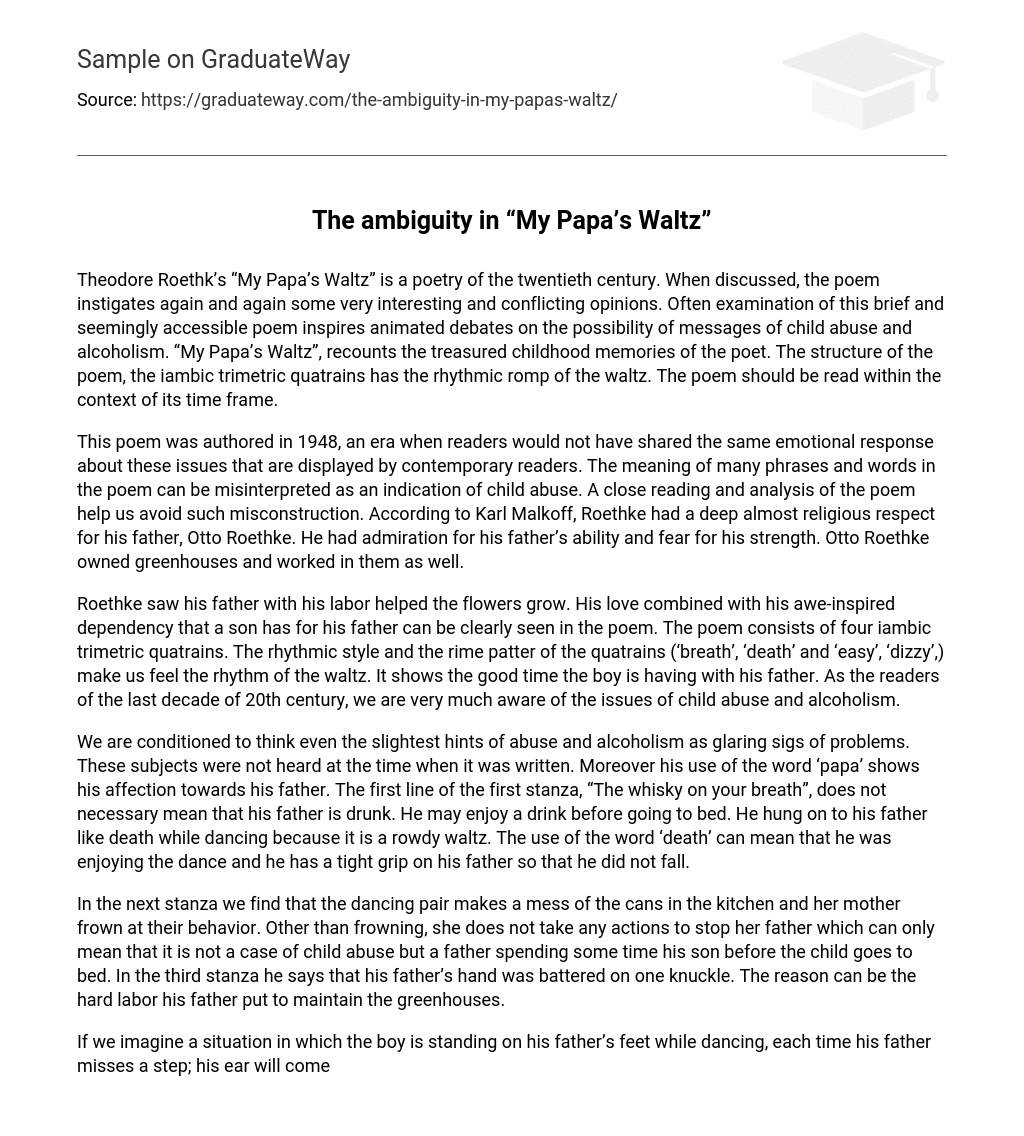Theodore Roethk’s “My Papa’s Waltz” is a poetry of the twentieth century. When discussed, the poem instigates again and again some very interesting and conflicting opinions. Often examination of this brief and seemingly accessible poem inspires animated debates on the possibility of messages of child abuse and alcoholism. “My Papa’s Waltz”, recounts the treasured childhood memories of the poet. The structure of the poem, the iambic trimetric quatrains has the rhythmic romp of the waltz. The poem should be read within the context of its time frame.
This poem was authored in 1948, an era when readers would not have shared the same emotional response about these issues that are displayed by contemporary readers. The meaning of many phrases and words in the poem can be misinterpreted as an indication of child abuse. A close reading and analysis of the poem help us avoid such misconstruction. According to Karl Malkoff, Roethke had a deep almost religious respect for his father, Otto Roethke. He had admiration for his father’s ability and fear for his strength. Otto Roethke owned greenhouses and worked in them as well.
Roethke saw his father with his labor helped the flowers grow. His love combined with his awe-inspired dependency that a son has for his father can be clearly seen in the poem. The poem consists of four iambic trimetric quatrains. The rhythmic style and the rime patter of the quatrains (‘breath’, ‘death’ and ‘easy’, ‘dizzy’,) make us feel the rhythm of the waltz. It shows the good time the boy is having with his father. As the readers of the last decade of 20th century, we are very much aware of the issues of child abuse and alcoholism.
We are conditioned to think even the slightest hints of abuse and alcoholism as glaring sigs of problems. These subjects were not heard at the time when it was written. Moreover his use of the word ‘papa’ shows his affection towards his father. The first line of the first stanza, “The whisky on your breath”, does not necessary mean that his father is drunk. He may enjoy a drink before going to bed. He hung on to his father like death while dancing because it is a rowdy waltz. The use of the word ‘death’ can mean that he was enjoying the dance and he has a tight grip on his father so that he did not fall.
In the next stanza we find that the dancing pair makes a mess of the cans in the kitchen and her mother frown at their behavior. Other than frowning, she does not take any actions to stop her father which can only mean that it is not a case of child abuse but a father spending some time his son before the child goes to bed. In the third stanza he says that his father’s hand was battered on one knuckle. The reason can be the hard labor his father put to maintain the greenhouses.
If we imagine a situation in which the boy is standing on his father’s feet while dancing, each time his father misses a step; his ear will come in contact with the buckle. This is what he means by “My ear scraped a buckle”. The first line of the last stanza, “You beat time on my head” may mean the father lovingly putting his hand on the boy’s head with the beat of the waltz. The last line “Still clinging to your shirt” reveals the boy’s wish to stay with his father and not go to bed. The analysis of the poem asserts that it is a recollection of the happy days of his childhood.
The autobiographical elements, the structure, the poem in context of the era in which it was written and a close study of the poem show that is a reminiscence of the loving memories of author’s childhood which had shared with his father. Though the poem seems to be a positive memory, there are lines, ‘The whisky on your breath’ and ‘But I hung on to like death’, which shows the violence and underlining danger in such a dance. The activity is exhilarating, as often with children, they are impressed by things that scare and thrill them.





